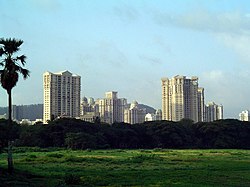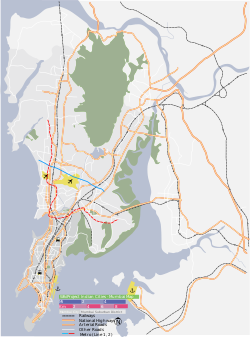Powai | |
|---|---|
suburb | |
 View of Powai from across the Powai lake, Mumbai (MH) | |
| Coordinates: 19°07′N 72°55′E / 19.12°N 72.91°E | |
| Country | India |
| State | Maharashtra |
| District | Mumbai Suburban |
| City | Mumbai |
| Zone | 5 |
| Ward | S |
| Government | |
| • Type | Municipal Corporation |
| • Body | Brihanmumbai Municipal Corporation (MCGM) |
| Elevation | 50 m (160 ft) |
| Languages | |
| • Official | Marathi |
| Time zone | UTC+5:30 (IST) |
| PIN | 400076[1] |
| Area code | 022 |
| Vehicle registration | MH-03[2] |
| Lok Sabha constituency | Mumbai North East (part)[3] Mumbai North Central (part)[4] |
| Vidhan Sabha constituency | Bhandup West (part) Chandivali (part) |
Powai (Pronunciation: [pəʋəiː]) is a residential suburb located in central Mumbai, Maharashtra, India. It is situated on the banks of Powai Lake, and is bound by the hills of Vikhroli Parksite to the south-east, Chandivali to the south-west, the L.B.S. Marg (old Mumbai-Agra road) to the north-east and the Sanjay Gandhi National Park to the north beyond the lake.[5] The Jogeshwari-Vikhroli Link Road, one of the city's busiest thoroughfares linking the western and eastern suburbs, passes through Powai.[6] The place also hosts thousands of devotees every year during the Ganesh Chaturthi festival for the visarjan processions.[7]
The Indian Institute of Technology, Bombay, established in 1958 and currently the second oldest campus of the Indian Institutes of Technology as well as the Indian Institute of Management Mumbai, established in 1963 are both located here,[8][9] as is a campus of the Bombay Scottish School.[10] Powai is also home to residential complexes of the Income Tax department, Customs and NTPC,[11] as well as those of ex-servicemen.[12] Powai houses schools and colleges, some of which are S M Shetty school and college, Gopal Sharma school and Chandrabhan Sharma College. Chandivali has Sinhgad college of management. New school includes Pawar Public school towards Chandivali.[13] Some of the Temples of Powai are Chinmaya Mission's Jagadeshwara Shiva Temple, Sri Ayyappa Vishnu Temple at Hiranandani, Devi Vageshwari Mata Temple at Chandivali. Powai also hosts community birthday havan.
Powai is also Mumbai's start-up hub, with young entrepreneurs like the hiranandanis. starting off from incubation cells set up by institutes like IIT Bombay from the tech industry and other sectors setting their bases there,[14] causing the area to be referred to as India's Powai Valley.[15] Some of the start-ups in Powai Valley include JustRide, Housing, TinyOwl, Toppr, HolaChef, Bewakoof, Logic Roots, Care24, Flyrobe, Nearfox, Belita, CredR, Mirchi and Mime and Crispy Games. As a result of the mixture of various communities living together, the suburb has one of the city's most cosmopolitan and modernized cultures.[16] The place has a vibrant night-life,[17][18] and shoots for several Bollywood as well as Hollywood movies, such as Kalyug, Ghajini, Slumdog Millionaire, Mardaani and Haseena Maan Jaayegi have taken place there.[19] The Hiranandani Gardens are also known for their neoclassical architectural style and the area has some of the tallest residential buildings in Suburban Mumbai.[20] The suburb is also known for being one of the preferred residential areas for expats in Mumbai.[21] Great access to sharing cycle ride company Yulu - the blue color cycles found convenient.[22]




